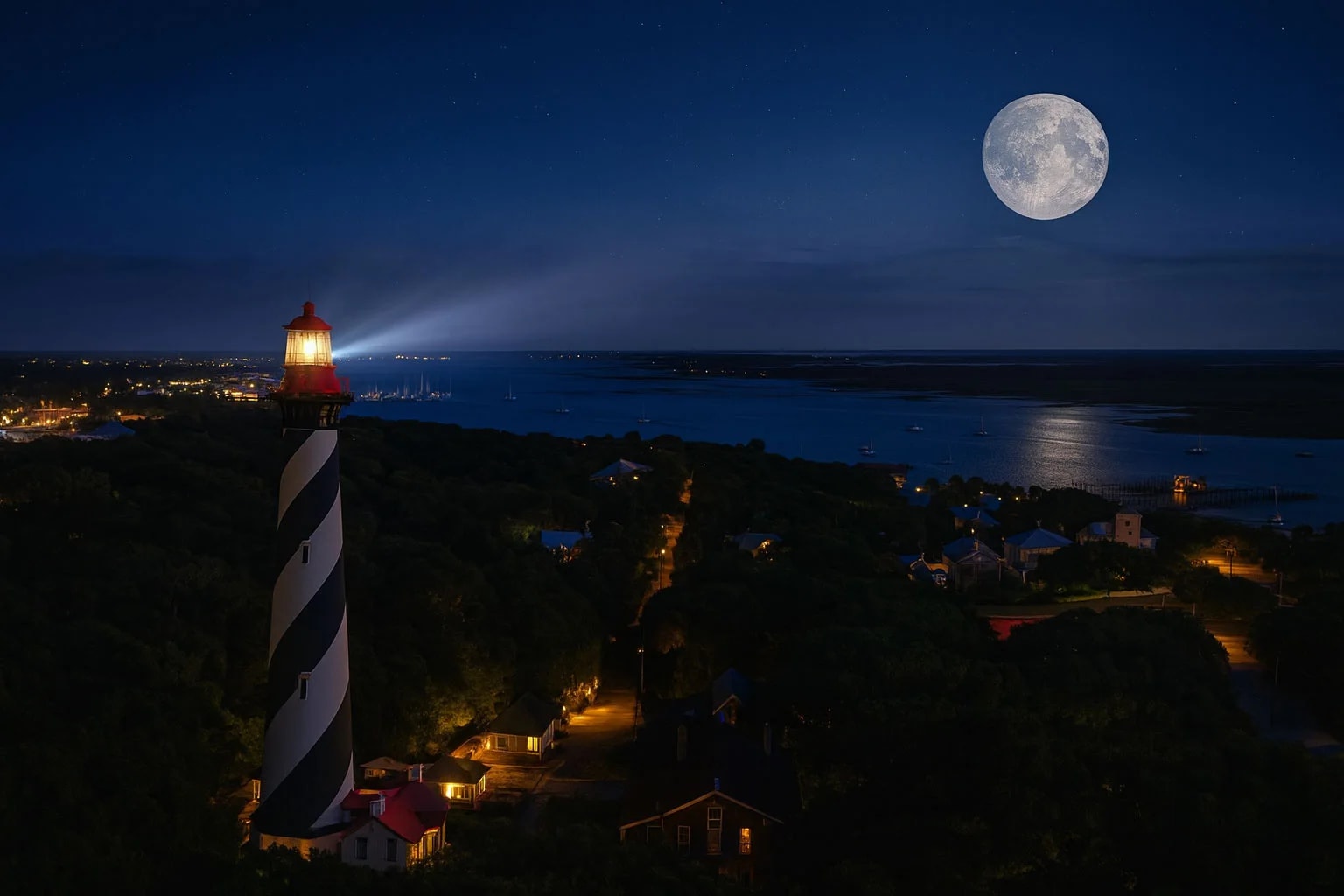Beacon for Souls Lost at Sea
Rising 165 feet above Anastasia Island, the St. Augustine Lighthouse has served as both a guardian of maritime safety and a magnet for supernatural activity since its completion in 1874. This magnificent brick tower replaced earlier Spanish colonial watchtowers that had guided ships through the treacherous waters off Florida's coast for over three centuries, inheriting not only their navigational duties but also the accumulated spiritual energy of countless maritime tragedies. The lighthouse's distinctive black and white spiral stripes have witnessed shipwrecks, hurricanes, yellow fever epidemics, and the personal dramas of the lighthouse keepers and their families who lived in isolation on this windswept barrier island. Yet for many of these souls, death has not ended their commitment to protecting mariners from the dangers that lurk beneath these deceptively beautiful waters. Visitors to this National Historic Landmark consistently report encounters with phantom lighthouse keepers still tending their eternal flame, the ghostly cries of shipwreck victims calling from the surrounding waters, and the apparitions of lighthouse families who continue their domestic routines despite having died decades ago. From the lamp room where spectral keepers maintain their vigil to the keeper's house where domestic spirits carry on their daily tasks, the St. Augustine Lighthouse offers one of America's most compelling maritime paranormal experiences.
Centuries of Maritime Tragedy and Triumph
The history of lighthouse operations at St. Augustine dates back to the Spanish colonial period, when watchtowers built atop the barrier island's highest dunes guided treasure galleons and merchant vessels through the complex network of sandbars and tidal channels that protected the ancient city's harbor. The original Spanish watchtower, constructed in the early 1600s, was repeatedly damaged by hurricanes and pirate attacks before being replaced by a more substantial stone structure in 1737. This colonial lighthouse served faithfully until coastal erosion undermined its foundation in the 1870s, necessitating the construction of the current lighthouse several hundred yards inland. The new lighthouse, completed in 1874 at a cost of $95,000, represented the pinnacle of 19th-century lighthouse engineering, featuring a first-order Fresnel lens that could be seen 19 miles at sea. The lighthouse's most tragic chapter began immediately upon completion, when yellow fever epidemics claimed multiple lighthouse keepers and their families between 1876 and 1888, leaving the tower temporarily abandoned as no one would accept the seemingly cursed position. The period from 1890 to 1955 brought relative stability under the dedicated service of the Rasmussen family, whose three generations of lighthouse keepers established the operational traditions that continue to manifest in supernatural form today. During World War II, the lighthouse served as a coastal observation post, with volunteers scanning the waters for German U-boats that were known to operate off Florida's coast. The lighthouse's automation in 1955 ended the era of residential keepers, though many former residents appear to have remained at their posts in spiritual form, continuing their maritime duties long after their physical deaths.
The Eternal Keepers
The most prominent spirit at the St. Augustine Lighthouse is Joseph Andreu, who served as head lighthouse keeper from 1875 until his tragic death in 1876 during a yellow fever epidemic that claimed his entire family within two weeks. Visitors climbing the lighthouse's 219 steps consistently report encountering him in period lighthouse keeper attire, still conducting his nightly inspections of the lamp room and lens apparatus as if ensuring the light continues to guide vessels safely to port. Joseph's spirit appears solid enough to cast shadows and often acknowledges visitors with a respectful nod before continuing his eternal rounds. His presence is accompanied by the distinctive sound of heavy work boots on metal stairs and the aroma of whale oil and brass polish that characterized 19th-century lighthouse operations. The lighthouse's most beloved spirit is little Eliza Rasmussen, the seven-year-old daughter of lighthouse keeper Hans Rasmussen, who died in 1894 when she fell from the lighthouse's exterior gallery while playing with her siblings. Her childish laughter echoes through the tower during daytime hours, and visitors often report seeing a young girl in Victorian dress playing on the spiral staircase or peering out from the lamp room windows. Eliza's spirit seems particularly drawn to children visiting the lighthouse, often attempting to engage them in games of hide-and-seek that span multiple levels of the tower. The keeper's house harbors the spirit of Maria Andreu, Joseph's wife, who continues her domestic duties as if her family were still alive and in need of her care. She appears as a woman in 1870s dress, often seen hanging laundry that vanishes when observed directly, tending to a garden that blooms with phantom flowers, and preparing meals in a kitchen where the aroma of period cooking periodically fills the air despite the absence of any actual food preparation.
Maritime Manifestations
Paranormal activity at the St. Augustine Lighthouse operates on multiple levels that reflect both the tower's operational history and the maritime tragedies that occurred in the surrounding waters. The lighthouse's spiral staircase serves as a supernatural highway where multiple spirits travel between the tower's various levels, with visitors consistently reporting the sound of footsteps ascending and descending when no living persons are present on the stairs. The lamp room experiences the most intense supernatural phenomena, with witnesses reporting the phantom operation of lighthouse equipment, the sound of lens apparatus being cleaned and adjusted, and the appearance of spectral flames in the Fresnel lens during periods when the lighthouse is not actively operating. Electronic equipment throughout the lighthouse complex behaves erratically, with cameras producing mysterious photographs of empty spaces that show period-dressed figures conducting lighthouse duties, and audio recordings capturing the sounds of 19th-century maritime operations including fog horns, ship bells, and keeper communications that predate radio technology. The lighthouse's unique acoustic properties, designed to carry sound across water, also amplify supernatural audio phenomena—visitors report hearing phantom ships' horns, distress calls from vessels that sank decades ago, and maritime communications in languages ranging from Spanish to English to French, reflecting the international character of ships that have sought the lighthouse's guidance throughout its history. During storms and foggy conditions, the lighthouse becomes extraordinarily active, with witnesses reporting the full operation of phantom lighthouse systems including automated fog signals, emergency lighting procedures, and keeper activities that suggest the supernatural staff continues to respond to dangerous maritime conditions as they would have during their living service.
Climbing to Supernatural Heights
The St. Augustine Lighthouse offers visitors the unique opportunity to experience authentic maritime history while encountering some of Florida's most dedicated supernatural residents. The lighthouse complex provides both daytime historical tours and evening paranormal investigations that explore the tower's operational heritage alongside its reputation as one of America's most haunted lighthouses. Climbing the lighthouse's 219 steps provides multiple opportunities for supernatural encounters, as the spiral staircase serves as the primary travel route for the tower's ghostly residents who continue their daily routines between the lamp room and keeper's quarters. Visitors should be prepared for the physical demands of the climb while remaining alert for supernatural phenomena including phantom footsteps, sudden temperature changes, and the possibility of encountering spirits conducting their eternal lighthouse duties on the stairs and landings. The lamp room offers the most intense paranormal experiences, though the confined space and height may not be suitable for all visitors—those who make the complete ascent are often rewarded with direct encounters with Joseph Andreu's spirit and the opportunity to witness phantom lighthouse operations that recreate 19th-century maritime safety procedures. Photography throughout the lighthouse complex produces exceptional paranormal evidence, particularly when capturing the Fresnel lens apparatus and maritime equipment that seem to serve as focal points for supernatural energy. The keeper's house provides additional paranormal opportunities in a more accessible environment, where visitors can encounter the domestic spirits who maintained lighthouse families while experiencing the isolation and dedication that characterized maritime service. Evening tours and overnight paranormal investigations offer the most comprehensive supernatural experiences, though advance reservations are essential due to the lighthouse's popularity among both history enthusiasts and ghost hunters seeking authentic maritime paranormal encounters.

Where Joseph Andreu maintains his eternal vigil

Eliza Rasmussen's playground spans 219 ghostly steps

Maria Andreu continues her lighthouse family duties

